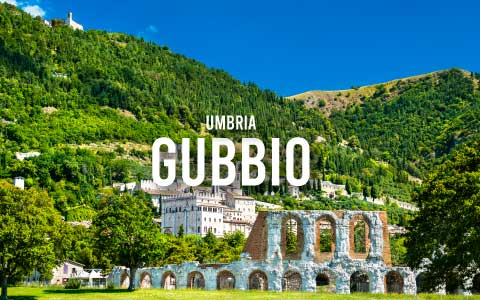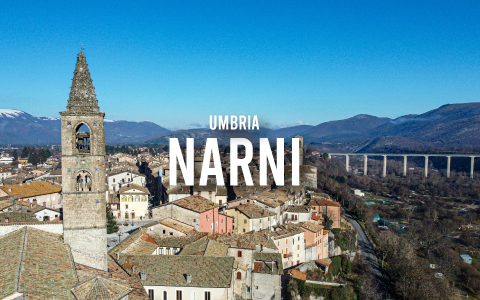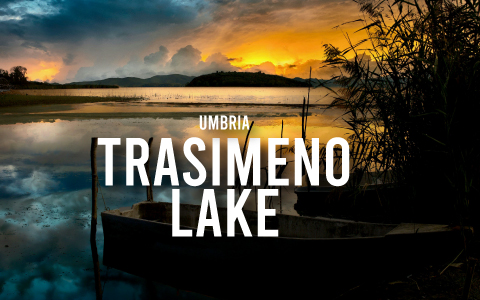
Exploring Gubbio: A Comprehensive Guide
Umbria is the green heart of Italy. The region is home to natural beauty such as Lake Trasimeno and the Marmore Falls, as well as charming towns such as Perugia, Assisi and Orvieto. Another town worth visiting is Gubbio. This medieval gem offers a unique blend of history, culture, and natural beauty.
History of Gubbio
Gubbio, one of the oldest towns in Umbria, boasts a rich and varied history dating back to the ancient Umbrians, who established the settlement in pre-Roman times.
The town rose to prominence under Roman rule, evidenced by the well-preserved Roman Theatre. During the medieval period, Gubbio flourished as a powerful city-state, constructing remarkable structures such as the Palazzo dei Consoli. It also played a significant role in the conflicts between the Guelphs and Ghibellines.
Gubbio’s historical significance is further underscored by the discovery of the Eugubine Tablets, which provide valuable insights into the early Umbrian civilization.
Today, its historical legacy continues to draw visitors from around the world, captivated by its timeless charm.
Top Attractions to See in Gubbio
To experience the best of a trip to Gubbio, it is good for you to know what attractions you should not miss. Here are our favorites.
Palazzo dei Consoli
This iconic palace, built in the 14th century, dominates the town’s skyline. It houses the Civic Museum, which features the Eugubine Tablets, seven bronze tablets that are among the most important inscriptions of the ancient Umbrian language.
Gubbio Roman Theatre
Located just outside the city walls, this ancient theatre dates back to the 1st century BC. It’s one of the largest and best-preserved Roman theatres in Italy, and during summer, it hosts various performances and events.
Roman Aqueduct
In ancient times, the Roman Aqueduct served as a crucial infrastructure for Gubbio, transporting water from the nearby mountains to the town’s water supply system. While some sections of the aqueduct have been lost over time, significant portions remain intact, showing the robust construction made of local stone and Roman concrete. Walking along its remains offers a glimpse into the ingenuity of the Romans and their impact on the development of Gubbio.
Basilica of Sant’Ubaldo
Situated on Mount Ingino, this basilica is dedicated to Gubbio’s patron saint, Ubaldo. It houses the saint’s incorrupt body and offers stunning views of the town below. You can reach the basilica via a scenic cable car ride.
Piazza Grande
This beautiful square, one of the town’s main landmarks, offers panoramic views of the surrounding countryside. It’s a great place to soak in the medieval atmosphere of Gubbio.
Cathedral of Gubbio (Duomo)
Dedicated to Saints Marian and James, this cathedral features beautiful frescoes and a striking Gothic facade. It’s located near the Palazzo Ducale, another significant historical site.
Activities and Experiences to do in Gubbio
In addition to visiting monuments and historic buildings, in the city of Gubbio you can have much more engaging experiences related to the peculiarities of the area.
One example is participating in the Corsa dei Ceri. Held annually on May 15, this is Gubbio’s most famous festival. It involves a thrilling race where participants carry large wooden statues of saints through the town’s streets, up to the Basilica of Sant’Ubaldo. The event is a spectacular display of local tradition and community spirit.
If you are into hiking, Gubbio is surrounded by beautiful countryside, ideal for walking and hiking. The Sentiero Francescano della Pace, a path connecting Assisi and Gubbio, is particularly popular. If you prefer to walk in the woods, why not going a truffle hunting expedition? Umbria is famous for its truffles, and Gubbio offers truffle hunting tours where you can learn about this prized ingredient and even try your hand at finding them.
Speaking about truffle, Gubbio boasts a rich culinary tradition with many restaurants and trattorias offering local Umbrian cuisine. Some must-try dishes include Crescia (a traditional flatbread often served with cured meats and cheeses), Torta al Testo (a savory stuffed flatbread) and, of course, truffles.
Practical Information to Enjoy Gubbio
The best time to visit Gubbio is during the spring (April to June) and autumn (September to October) when the weather is mild and the town is less crowded. The Corsa dei Ceri in May is a highlight but expect larger crowds during this time.
If you want to take home a great souvenir, the town offers a variety of shopping opportunities, especially for those interested in local crafts and products. Look out for hand-painted ceramics, high-quality and handmade leather goods, wine and spirits, and truffle products such as truffle-infused oils, sauces, or even fresh truffles when in season.
Reaching Gubbio is quite simple since the town is well-connected by road to the rest of Umbria, and parking is available at various points around the town. If you prefer the train, Gubbio does not have its own train station. The nearest stations are in Perugia and Fossato di Vico, from where you can take a bus or taxi to Gubbio.



